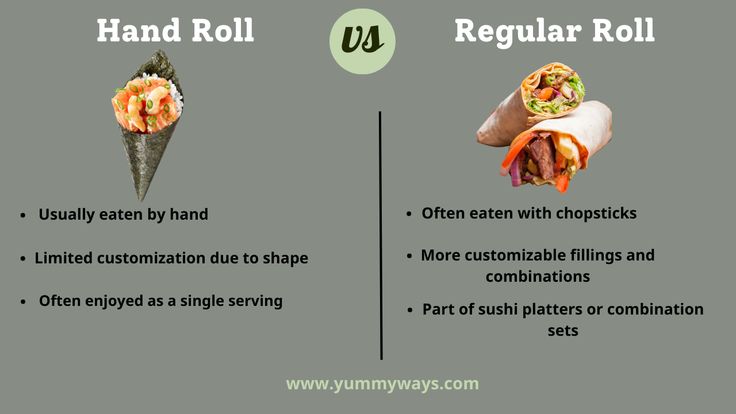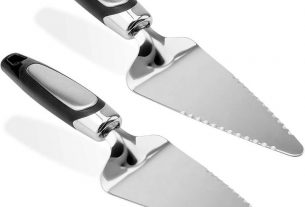Who can resist the allure of sushi?
Delicate, flavorful, and artfully prepared, this Japanese delicacy has captured the hearts and taste buds of people worldwide.
But have you ever wondered about the differences between a sushi roll and a hand roll?
From the way they are eaten to the endless possibilities of fillings, join us on a tantalizing journey to uncover the secrets behind these two tantalizing treats.
Get ready to embark on a culinary adventure that will leave you craving more.
sushi roll vs hand roll
The main difference between a sushi roll and a hand roll lies in their shape and method of consumption.
Sushi rolls, also known as makizushi, are made by layering nori, seasoned sushi rice, and fresh fish and/or vegetables, and are then cut into bite-sized pieces.
They are typically eaten with chopsticks.
On the other hand, hand rolls, or temaki, are made with a bed of seasoned sushi rice and various ingredients wrapped in a folded sheet of nori, resembling a cone shape.
Hand rolls are eaten with hands and are not cut into smaller pieces.
Despite being less popular, hand rolls are growing in popularity and can be found in specific restaurants dedicated to serving them.
Key Points:
- Sushi rolls (makizushi) are made by layering nori, sushi rice, and fresh fish/vegetables, and are cut into bite-sized pieces.
- Sushi rolls are typically eaten with chopsticks.
- Hand rolls (temaki) are made with a bed of seasoned sushi rice and ingredients wrapped in a folded sheet of nori, resembling a cone shape.
- Hand rolls are eaten with hands and are not cut into smaller pieces.
- Hand rolls are less popular but are growing in popularity and can be found in specific restaurants.
- The main difference between a sushi roll and a hand roll is their shape and method of consumption.
sushi roll vs hand roll – Watch Video
💡
Pro Tips:
1. Maki, the Japanese word for sushi roll, actually means “rolled sushi” in English. It refers to the cylindrical sushi rolls that are made by wrapping rice and other ingredients in a sheet of seaweed called nori.
2. Hand rolls, also known as temaki, are a popular type of sushi that is shaped like a cone. They are typically made by hand, hence the name, and eaten immediately after being prepared to enjoy the freshness of the ingredients.
3. Sushi rolls are often cut into small bite-sized pieces, typically six or eight per roll. However, hand rolls are meant to be eaten in a single hand-held bite, making them a convenient and delicious option for someone on the go.
4. While sushi rolls are usually filled with a variety of ingredients, such as fish, vegetables, and sauces, hand rolls often feature a single filling or a few complementary ingredients. This allows the flavors to be more pronounced and distinct in each bite.
5. Sushi rolls are commonly eaten with chopsticks, as they are neatly cut into uniform pieces. On the other hand, hand rolls are traditionally eaten with the hands to fully savor the textures and taste, as the cone shape prevents them from being easily picked up with chopsticks.
Origins Of Sushi: China To Japan
Sushi, a beloved Japanese delicacy, originated in ancient China. The idea of fermented fish and rice was brought to Japan in the 8th century, and over time, it evolved into the sushi we are familiar with today. Although China had its own version of sushi known as nare-zushi, it was in Japan that sushi truly thrived. The Japanese not only perfected the technique and presentation of sushi but also made it an essential part of their culture.
To summarize:
- Sushi has its roots in ancient China but reached its prime in Japan.
- The concept of fermented fish and rice was introduced to Japan in the 8th century.
- Sushi became an integral part of Japanese culture and underwent refinement in its technique and presentation.
Sushi: The Meaning Behind The Name
The word “sushi” itself has an interesting origin. In Japanese, “su” means vinegar, and “shi” means rice. Therefore, sushi can be translated to “sour” or “sour-tasting,” referring to the vinegared rice that is the essential component of sushi. This unique flavor provides a delightful contrast when paired with the fresh fish and other ingredients commonly found in sushi.
- “Su” means vinegar in Japanese
- “Shi” means rice in Japanese
- Sushi can be translated to “sour” or “sour-tasting”
- Vinegared rice is the essential component of sushi
- Contrasting flavors in sushi bring a delightful taste experience
Sushi: A delightful combination of vinegared rice and fresh fish.
The First Sushi: Nare-Zushi
During the Heian period in Japan, Nare-zushi, commonly known as “aged-sushi,” emerged as the precursor to modern sushi. This traditional method involved fermenting fish with rice, salt, and vinegar, resulting in preserved fish that could be safely consumed. This innovation significantly extended the shelf life of the fish, allowing for its transportation over long distances.
The evolution of Nare-zushi eventually led to the development of various sushi types that we enjoy today, including maki rolls and hand rolls. These advancements in sushi preparation techniques allowed for greater versatility and customization in flavors and presentation.
To summarize:
- Nare-zushi, or aged-sushi, was an early form of sushi developed during the Heian period in Japan.
- This preservation method utilized fermentation with rice, salt, and vinegar to prolong the shelf life of the fish.
- Over time, new sushi variations like maki rolls and hand rolls emerged from the refinement of Nare-zushi.
“The preservation method of Nare-zushi involved fermenting fish with rice, salt, and vinegar, greatly increasing its shelf life.”
Maki Rolls Vs. Temaki: Bite-Size Vs. Hand Rolls
When it comes to sushi rolls, there are two primary variations:
-
Maki rolls: These are cut into bite-size pieces, making them perfect for sharing or enjoying individually. The small size of maki rolls allows for easy consumption and promotes a communal dining experience.
-
Temaki: On the other hand, temaki refers to hand rolls, each designed to be eaten in one hand. Unlike maki rolls, temaki is not cut into smaller portions. This makes it ideal for those who prefer a more handheld dining experience.
These two different types of sushi rolls offer unique dining experiences for sushi lovers. Whether it’s enjoying bite-sized maki rolls with friends or savoring a hand roll on the go, both options provide a delicious way to enjoy sushi.
- In maki rolls, the sushi rice and fillings are enclosed in a seaweed wrapper, which is then cut into smaller pieces.
- Temaki, on the other hand, is a cone-shaped roll made by wrapping the sushi rice and fillings in a single sheet of seaweed.
“The different sizes and shapes of maki rolls and temaki provide sushi enthusiasts with diverse dining experiences.”
Cut Sushi Rolls: Makimono, Makizushi, Norimaki
Cut sushi rolls, also known as makimono, makizushi, or norimaki, are a popular type of sushi. They are made by wrapping sushi rice and various fillings in nori seaweed. The term makimono is used to describe all types of rolled sushi, while makizushi specifically refers to rolled sushi with fillings. On the other hand, norimaki refers to sushi rolls that are wrapped in nori seaweed.
Makizushi: Layering Nori, Sushi Rice, And Fresh Ingredients
One of the most popular types of sushi rolls is makizushi. Magically combining layers of nori, seasoned sushi rice, and fresh fillings, makizushi offers a burst of flavors and textures with each bite. The nori acts as a protective layer around the rice, keeping it intact and adding a savory element to the overall taste. Makizushi provides infinite opportunities for creativity and exploration, allowing for an endless array of combinations and flavors.
- Makizushi is a popular type of sushi roll.
- It combines nori, seasoned sushi rice, and fresh fillings.
- The nori acts as a protective layer and adds flavor.
- Makizushi offers a burst of flavors and textures.
- It allows for endless combinations and flavors.
“Makizushi provides infinite opportunities for creativity and exploration, allowing for an endless array of combinations and flavors.”
Makizushi Variations: Thin And Thick Rolls
There is versatility within the world of makizushi, offering both thin (hosomaki) and thick (futomaki) rolls. Hosomaki translates to “thin roll,” where a single ingredient, typically fish or vegetable, is used as the filling. This simplicity allows the taste of the filling to shine through. On the other hand, futomaki, which means “thick roll,” incorporates multiple ingredients, creating a harmonious blend of flavors and textures in every bite.
- Makizushi offers versatility with thin and thick rolls
- Hosomaki refers to the thin roll with a single ingredient as filling
- Futomaki incorporates multiple ingredients for a blend of flavors and textures.
Sushi Restaurant Offerings: Classic, Regular, Specialty Rolls
Sushi restaurants cater to a diverse range of taste preferences, offering classic, regular, and specialty rolls. Classic rolls typically consist of timeless combinations like California rolls or spicy tuna rolls, satisfying the tastes of both traditional and adventurous sushi enthusiasts. Regular rolls introduce unique flavor profiles and exciting ingredient combinations, while specialty rolls push the boundaries of creativity, presenting sushi lovers with an extraordinary culinary experience.
- Classic rolls: California rolls, spicy tuna rolls
- Regular rolls: Unique flavor profiles, exciting ingredient combinations
- Specialty rolls: Pushing the boundaries of creativity, extraordinary culinary experience.
Hand Rolls: A Unique Sushi Experience
Hand rolls provide a unique sushi experience. Unlike traditional sushi rolls, hand rolls are meant to be eaten as a whole, without being cut into bite-sized pieces. The hand roll is crafted by wrapping seasoned sushi rice and a variety of ingredients in a cone-shaped nori sheet, creating a resemblance to a taco. This convenient and one-handed meal option offers a delightful and enjoyable dining experience.
Some key points about hand rolls:
- Hand rolls are not cut into pieces, but consumed as a whole.
- The combination of seasoned sushi rice and ingredients is neatly wrapped in a cone-shaped nori sheet.
- The presentation of a hand roll adds excitement and novelty to the dining experience.
“Hand rolls offer a distinct and enjoyable sushi experience. The combination of sushi rice and ingredients wrapped neatly in a cone-shaped nori sheet resembles a taco, creating a convenient and one-handed meal option.”
Hand Roll Popularity And Noteworthy Restaurants
While sushi rolls dominate the sushi scene, hand rolls are steadily gaining popularity among sushi enthusiasts. Noteworthy restaurants specializing in hand rolls, such as KazuNori and Temakira, have emerged, showcasing the beauty and simplicity of this style of sushi. With fillings ranging from baked salmon skin to spicy tuna, hand rolls offer a diverse and satisfying array of flavors, further fueling their rise in popularity.
In conclusion, sushi rolls and hand rolls each offer their own unique sushi experience. Sushi rolls, with their bite-size pieces and variety of fillings, are perfect for sharing and enjoying with chopsticks. On the other hand, hand rolls provide a convenient and novel one-handed sushi experience, with the opportunity to savor a complete roll in each bite. Whether you prefer the classic elegance of sushi rolls or the tactile enjoyment of hand rolls, both styles contribute to the rich and diverse world of sushi.
💡
You may need to know these questions about sushi roll vs hand roll
Is a California roll a hand roll?
While a California roll and a hand roll share some similarities, they are not exactly the same. The California roll is a popular sushi roll that typically consists of crab meat, avocado, and cucumber. However, it is rolled with a sheet of seaweed and is typically cut into bite-sized pieces. On the other hand, a hand roll, such as the California hand roll, is made by wrapping the ingredients in a cone-shaped seaweed wrapper. This allows for a more convenient and portable eating experience. So, while the California roll may be a component of the California hand roll, they are not synonymous.
What size is a hand roll sushi?
A hand roll sushi typically measures around 4 inches in length. The unique cone shape of this roll allows the ingredients to be neatly tucked within the outer layer of nori, a thin sheet of seaweed. This compact size and shape make it an ideal choice for a quick and convenient finger food, best enjoyed immediately to preserve the delightful crispness of the nori.
What is the difference between sushi roll and maki?
While sushi is a broad term encompassing various forms of rice-based dishes, maki specifically refers to a type of sushi roll. The main difference between the two lies in their preparation and presentation. Sushi can come in different forms, such as nigiri (a small mound of rice topped with raw fish) or sashimi (thin slices of raw fish served without rice). On the other hand, maki is created by rolling the rice and fillings in a sheet of seaweed called nori, creating a cylindrical shape. It is then sliced into bite-sized pieces, making it convenient and easy to eat with chopsticks. In essence, maki is a specific type of sushi roll that is known for its rolled and sliced presentation.
What is sushi vs California roll?
Sushi refers to a traditional Japanese dish made of vinegared rice, typically wrapped in seaweed and filled with different ingredients such as raw or cooked fish, vegetables, or eggs. It is often served with soy sauce, wasabi, and pickled ginger. On the other hand, the California roll is a popular variation of sushi originating from the United States. Unlike traditional sushi, the California roll does not use seaweed to wrap the rice. Instead, the outer layer consists of rice sprinkled with toasted sesame or tobiko. Inside, you will find fillings like cucumber, crab stick or salad, and avocado. This fusion roll has gained popularity for its milder flavors and familiar ingredients, appealing to a wider range of palates.
Reference source
https://casasensei.com/interesting-facts/difference-between-roll-and-hand-roll-sushi/
https://nomnompaleo.com/post/108518507738/whole30-day-19-crab-avocado-temaki
https://www.mysushihouse.com/sushi-guide
https://www.dictionary.com/compare-words/maki-vs-sushi



